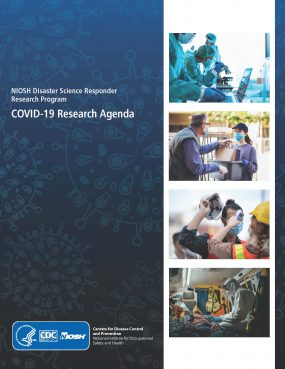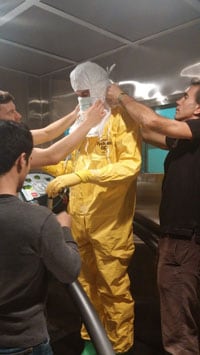Disaster Science Responder Research Program

The NIOSH Disaster Science Responder Research (DSRR) Program has developed a COVID-19 research agenda to address occupational health research gaps in the context of the ongoing response. Critical topic areas addressed in the agenda include: Economics; Engineering Controls; Epidemiology/Surveillance; Mental Health; Occupational Environmental/Exposure Assessment; Occupational Violence; Personal Protective Equipment; Transmission/Occupational Health; Zoonosis.

NIOSH staff members evaluating healthcare worker protection used in the Ebola response under simulated West Africa weather conditions.
NIOSH established the Disaster Science Responder Research (DSRR) Program to develop an approach that allows for timely and scalable responder-based research that can be implemented before, during, and after a public health emergency.
The goal of the DSRR Program is to implement a framework that allows for occupational safety and health research to be started quickly when a disaster or public health emergency occurs, without interfering with the response itself.
The types of research conducted may include:
- the impact of a novel exposure
- unexpected or severe health effects
- the effectiveness of a proposed intervention
- mental health/resilience issues
- disease outcomes with latency periods
The DSRR Program looks at all workers impacted by the disaster or public health emergency not only traditional response and recovery workers.
Strategic Goals
The DSRR strategic goals include:
- Identify critical topic areas to enhance safety and health among all workers impacted by public health emergencies;
- Address major logistical, technical and administrative challenges associated with conducting research during a public health emergency;
- Identify existing data collection capabilities and information resources that can be utilized or modified for occupational research purposes; and
- Ensure study findings are rapidly disseminated to inform the ongoing response.
Critical Topic Areas and Current Activities for the COVID-19 Response
While some disaster science research projects are best conducted during an ongoing response, the program also aims to identify critical topic areas to address research gaps that can be studied outside the scope of an ongoing response.
The critical topic areas include:
- Economics
Economic research on worker safety, health, and well-being during the COVID-19 crisis is critical because it assesses the effects of economic factors (e.g. unemployment) and the most cost-effective prevention strategies (e.g. physical distancing, personal protective equipment) to improve worker well-being and reduce economic burden for workers, their families and employers, and society overall.
- Engineering Controls
Engineering controls protect workers from COVID-19 by eliminating or reducing possible exposures. Examples include improved ventilation to dilute viral particles and modification of workstations, including use of physical barriers, to maintain worker separation. Well-designed engineering controls can be highly effective in protecting workers without impacting productivity or personal comfort. - Epidemiology/Surveillance
Epidemiologic studies are of critical importance to identify and characterize the impact of COVID-19 on frontline workers. There is a need for epidemiologic assessment that includes work-related and individual risk factors for infection, and widespread, comprehensive surveillance of infection among U.S. workers. - Mental Health
Public health emergencies may lead to mental health outcomes such as post-traumatic stress disorder (PTSD) and depression among all workers impacted by the response. In response to the current COVID-19) pandemic, there is a need to rapidly identify which workers are affected by trauma and are at highest risk of developing subsequent anxiety-related disorders, PTSD and depression. - Occupational Environment/Exposure Assessment
Exposure assessment is critical to understand the risk of infection in workplace settings. Methods to measure the existence and infectivity of SARS-CoV-2 in both aerosols and on surfaces at concentrations near an infectious dose need to be developed and validated to ensure results can be consistently interpreted and applied to protect workers. Laboratory experiments will assess virus transmission, the stability of the virus on surfaces and in aerosols, source control measures, and procedures for environmental aerosol sampling and quantifying the total infectious viral load. - Occupational Violence
Workplace violence (WPV) includes verbal and physical abuse, homicides, and suicides. COVID-19-related WPV assessments must recognize changing risk factors related to enforcement of disease prevention efforts and unprecedented unemployment and financial loss. Methods should be developed to track violence patterns, assess contributing factors, and identify prevention strategies during the pandemic. - Personal Protective Equipment
Personal protective equipment (PPE) is the last line of defense in the hierarchy of controls but is heavily relied upon in the current COVID-19 pandemic. Novel respiratory protective devices and respirators not traditionally used in healthcare environments are being used as part of crisis capacity strategies. Research is needed to understand the performance and limitations of these respiratory protective devices. - Transmission/Occupational Health
Multidisciplinary research to clarify the details of SARS-CoV-2 transmission in work settings and to translate advances in diagnosis and treatment of COVID-19 into improved workplace primary and secondary prevention strategies is critical to returning employees back to work in the safest way possible. This work will require collaborative efforts of many disciplines in many settings, including field studies, demonstration projects, laboratory research, and others. - Zoonosis
Research studies are needed to further investigate the animal species that are most susceptible to SARS-CoV-2 infection and whether they may be a potential workplace risk to veterinary and other animal workers. Surveillance of animals in close contact with infected humans will provide important public health information about virus transmission from humans to animals and whether transmission from animals to humans may be a concern from some animal species in certain work environments.
Contact Information
Angela Weber (amw1@cdc.gov)
Related NIOSH Resources
- Emergency Preparedness and Response Directory
- Guidance Documents for Protecting Emergency Responders
- NIOSHTIC-2 Search Results for Emergency Response
Additional Resources
- A Decision Process for Determining Whether to Conduct Responder Health Research Following Large Disasters
- Call to Action: Include Scientific Investigations as an Integral Component of Disaster Planning and Response. A Report from the National Biodefense Science Board
- Recommendations for Biomonitoring of Emergency Responders: Focus on Occupational Health Investigations and Occupational Health Research
- Research as a Part of Public Health Emergency Response
